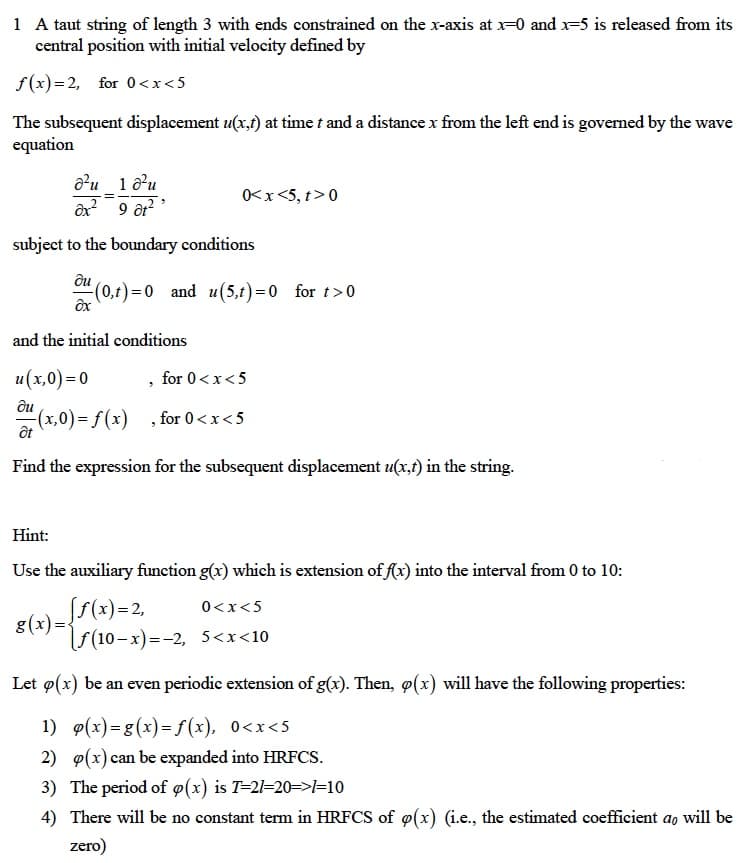The subsequent displacement u(x,f) at time t and a distance x from the left end is govemed by the wave equation a?u 1ôu ô 9 ôr? OKx<5, t>0
The subsequent displacement u(x,f) at time t and a distance x from the left end is govemed by the wave equation a?u 1ôu ô 9 ôr? OKx<5, t>0
Advanced Engineering Mathematics
10th Edition
ISBN:9780470458365
Author:Erwin Kreyszig
Publisher:Erwin Kreyszig
Chapter2: Second-order Linear Odes
Section: Chapter Questions
Problem 1RQ
Related questions
Question

Transcribed Image Text:1 A taut string of length 3 with ends constrained on the x-axis at x-0 and x-5 is released from its
central position with initial velocity defined by
f(x) = 2, for 0<x<5
The subsequent displacement u(x,f) at time f and a distance x from the left end is governed by the wave
equation
a?u 1 a?u
9 ôr?
0<x<5, t>0
subject to the boundary conditions
ди
(0,t)=0 and u(5,t)=0 for t>0
ôx
and the initial conditions
u(x,0)= 0
, for 0<x<5
ôu
(x,0)= f (x) , for 0<x<5
ốt
Find the expression for the subsequent displacement u(x,t) in the string.
Hint:
Use the auxiliary function g(x) which is extension of fx) into the interval from 0 to 10:
fs(x)=2,
(F(10-x)=-2, 5<x<10
0<x<5
g(x)=
8(x):
Let ø(x) be an even periodic extension of g(x). Then, o(x) will have the following properties:
1) 9(x)=g(x)=f(x), 0<x<5
2) 9(x) can be expanded into HRFCS.
3) The period of ø(x) is T=21=20=>l=10
4) There will be no constant term in HRFCS of 9(x) (i.e., the estimated coefficient ao will be
zero)
Expert Solution
This question has been solved!
Explore an expertly crafted, step-by-step solution for a thorough understanding of key concepts.
Step by step
Solved in 2 steps with 1 images

Knowledge Booster
Learn more about
Need a deep-dive on the concept behind this application? Look no further. Learn more about this topic, advanced-math and related others by exploring similar questions and additional content below.Recommended textbooks for you

Advanced Engineering Mathematics
Advanced Math
ISBN:
9780470458365
Author:
Erwin Kreyszig
Publisher:
Wiley, John & Sons, Incorporated

Numerical Methods for Engineers
Advanced Math
ISBN:
9780073397924
Author:
Steven C. Chapra Dr., Raymond P. Canale
Publisher:
McGraw-Hill Education

Introductory Mathematics for Engineering Applicat…
Advanced Math
ISBN:
9781118141809
Author:
Nathan Klingbeil
Publisher:
WILEY

Advanced Engineering Mathematics
Advanced Math
ISBN:
9780470458365
Author:
Erwin Kreyszig
Publisher:
Wiley, John & Sons, Incorporated

Numerical Methods for Engineers
Advanced Math
ISBN:
9780073397924
Author:
Steven C. Chapra Dr., Raymond P. Canale
Publisher:
McGraw-Hill Education

Introductory Mathematics for Engineering Applicat…
Advanced Math
ISBN:
9781118141809
Author:
Nathan Klingbeil
Publisher:
WILEY

Mathematics For Machine Technology
Advanced Math
ISBN:
9781337798310
Author:
Peterson, John.
Publisher:
Cengage Learning,

